My Cake Sank in the Middle. Why?!
Help! My cake sank in the middle! Without being at the “scene of the crime”, it would be difficult to pinpoint an exact reason why a cake sank in the middle, but if/when it happens to you, here a few reasons why it may have happened, and how you can, hopefully, prevent it from happening again.
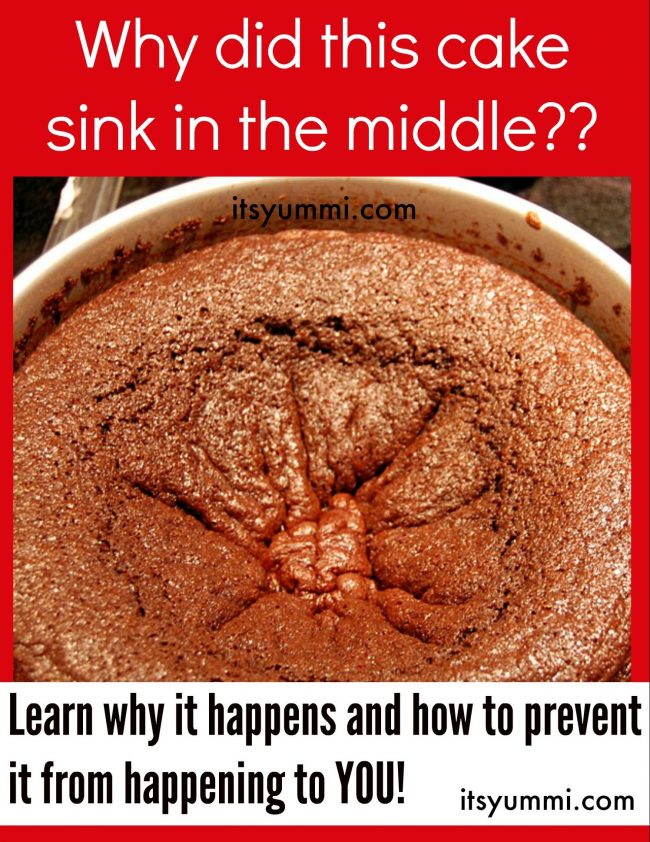
Possible Reasons Why a Cake Sank in the Middle
Expired Baking Powder or Baking Soda
Leavening products may only account for a small portion of the overall ingredients in a cake, but they’re a key component of your finished product, and your baked goods can be ruined if you’re not careful in checking to assure that the product is still “alive and well”!
Remember that baking powder and soda only stay fresh for about 6 months to a year, so date them when you buy them, and toss and replace any containers that have been hanging around too long.
Not sure if your baking powder or baking soda is still good?
- Testing Baking Powder: Place 1 teaspoon baking powder into a cup and add 1/3 cup hot tap water.
- Testing Baking Soda: Place 1/4 teaspoon baking soda into a cup and add 2 teaspoons vinegar.
If active bubbling occurs, the products are fine to use. If not, they should be replaced.
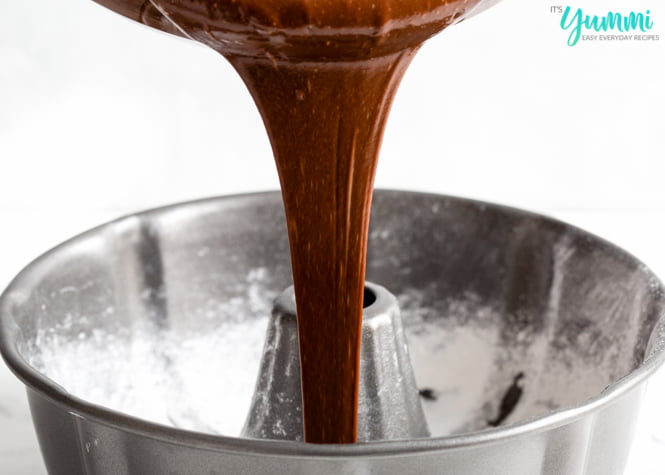
Too Much Leavening Agent
This might sound crazy, but adding too much baking powder, baking soda, or yeast to baked goods can cause it to sink, as the amount of air that is created within the cake will be more than the structure can support. You’ll blink your eyes and the whole thing will come crashing down.
Never add additional baking powder or other leavening agents to self-rising flour or cake mixes. They already include one. Also, be sure to read a recipe clearly and measure carefully.
When in doubt, remember that the average ratio for baking powder to flour is 1 to 1.5 teaspoons per cup of AP flour; so if you read a recipe that calls for something way above that, it’s probably an error.
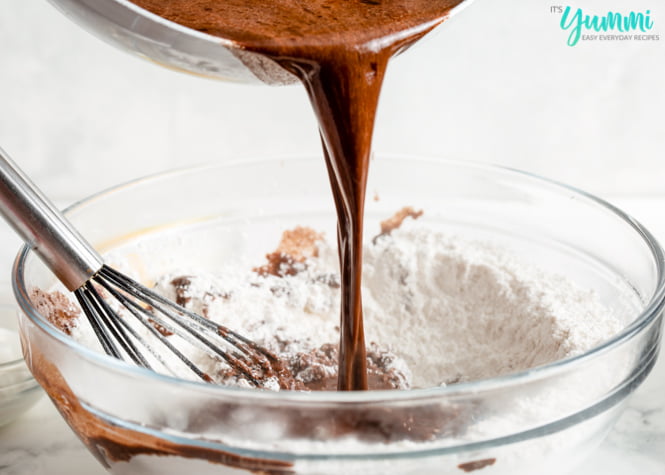
Over Mixing the Batter is one of the most commons reasons why a cake sinks in the middle!
This is probably one of the most common reasons why cakes sink. I’m not sure what it is, but we all seem to have a natural tendency towards over mixing cake batter.
Many people don’t stop until it is smooth and creamy, which is actually not what a properly mixed cake batter should look like. This is even easier to do when we rely on the trusty old Kitchen Aid or food processor to do our mixing for us.
But beating in too much air into the batter once the dry and wet ingredients are combined will only cause the batter sink. Mix the batter until the dry ingredients are just barely incorporated. If you see a few specks of flour here and there, it’s perfectly okay to leave it alone. The flour will incorporate during baking.
How to ensure you do not over mix the batter
- Go ahead and work the air in when creaming the butter, sugar, and eggs, but as soon as you add the flour mixture, remember that it’s ALL about the light hand.
- Fold the dry ingredients through the wet only until they are just combined, then delicately divide and pour into your cake pans.
- If adding anything at the end (food coloring, chocolate chips, nuts, etc.), continue to work the addition through the batter as gently as possible in a flowing folding motion.
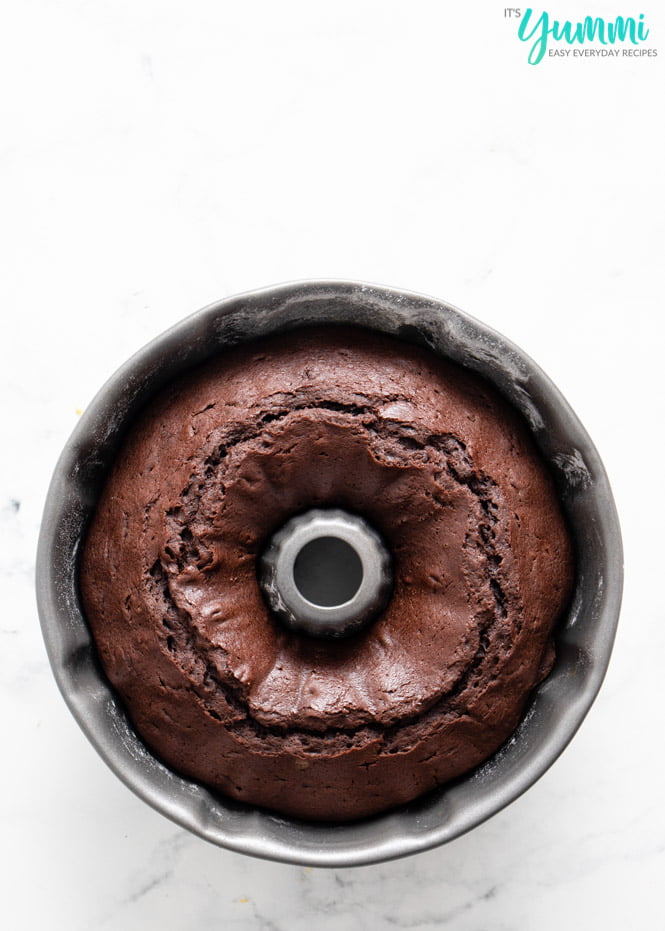
Incorrect Oven Temperature can sink a cake in the middle
An oven that isn’t properly calibrated can run either too hot or too cold. This can easily cause a cake to fall during the baking process, and sometimes afterward, especially if there’s a drastic temperature difference between the oven heat and the air temperature in the room.
If possible, spring for an external oven thermometer to make sure that when it says 350 on the dial, it’s really 350 inside the oven. I actually test my oven heat in 3 spots (far back corner top, far right corner lower, and center front) once per year. I move things around the oven to compensate for hot and cold spots.
Also, don’t be tempted to peek inside that oven for at least the first 80% of the suggested baking time. Remember that each time you open the oven door, the temperature inside can drop as many as 10 degrees. These tiny fluctuations in temperature can affect the even rising of the cake.
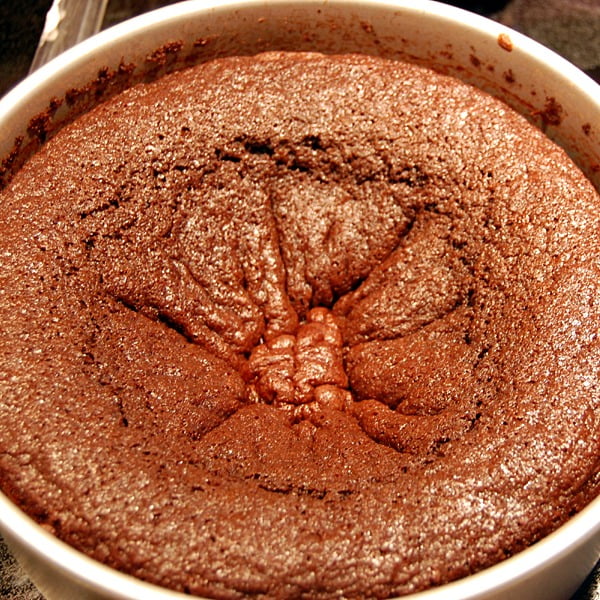
Timing
Unless a recipe specifically calls for it, don’t let a finished batter sit for very long before baking. 20-25 minutes while the first batch bakes is fine; a few hours while you run out to pick up the kids and finish some errands is not.
Remember that the minute the wet and dry ingredients meet, a chemical reaction starts to take place (like those baking soda volcanoes we all made in 7th grade science class).
To get a light, fluffy, and beautifully raised cake, you want that chemical reaction to take place inside the oven as the cake bakes so that the air that is created gets sealed into the baking cake. If your batter is sitting on the counter or on the fridge, the air created inside will just escape into the room, and come time for baking, there will be less to lift the cake up.
I hope these tips help you create a beautiful baked product in the future!

This is why one needs patience for baking and I have to be in a good mood to do it. Thank you for the tips, great post.
Being in a good mood before entering the kitchen is always better than shuffling your way through it, Janette! <3
We have all been there. You have a lot of courage to share this with us.
Thanks, Peter! If sharing my baking failures helps prevent it from happening to someone else, it’s a win-win for everyone!
Thanks, Tara, and you’re welcome!
So helpful – no bigger bummer than a cake that sinks in the middle!
Jessie, when your cake sinks in the middle, it’s a little bit like the end of the world as we know it. Just eat chocolate and bake another cake…. It works for me 😀
Thanks for the tips. I didn’t realize my baking powder expired that quickly. I swear I once had a can that had to be at least five years old.
Hey Mama! Of course, the leavener expiration is a general guideline and not a hard ‘n fast rule of law. I’ve had mine in the pantry for almost a year and it still works fine. I usually do a test of it every 6 months… the same time I’m testing my dried spices to see if they have any flavor left 😉
Great post Becca. I love this kind of thing. The too much leavener thing, not many people know that, but once you think about it, it makes perfect sense.
Thanks, Katie! I totally agree… it can be easy to see such a small amount of baking soda or baking powder and think, “oh gee, that’s not enough… a little more won’t hurt!” Oh how wrong that can be! 🙂
Great post, Chef Bec! I am totally going to tap into your baking skillz. There’s nothing worse than a baking flop, right? (I had one of those earlier this week…so I just got back up on my horse and made another cake…immediately!)
Thanks, Dave! You feel free to tap into my inner chef any time, and I’ll just keep tapping into your crazy awesome yeast guru skillz! 😀 I’m SO glad that you jumped back on to the baking horsey. He’s so lonely without you!
OOh- so love this post – yup I sure have suffered from fallen cake syndrome myself – I had no idea that too much leavening could cause it too! Thanks so much for this info. Btw, am loving this feature – wish it was on a more frequent basis…
I’m SO happy when I can be helpful to my readers and my friends…instead of the typical pain in the butt that I am! 😀 I just started this feature, Shashi, but I’m sure hoping that it becomes popular so that I can keep it here!
i just cover that part up with frosting
This is such a great informative post! I have only had my cake sink in the middle once, but I bet overmixing was the culprit. I have a tendancy to just mix mix mix mix mix — I don’t know why! I’ll be more mindful in the future!
That’s a great list of reasons. I think I often over mix my cakes.
Thank you so much Chef. I am fond of opening my oven to check if the temperature is ok as i use an old oven?. Also, i some times over mix especially when adding color and flavors. Most times when its fruit cake, i tend to mix much and keep the rest as i wait for the fast batch to bake.. am a culprite in so many ways. My God! Am glad i read this.